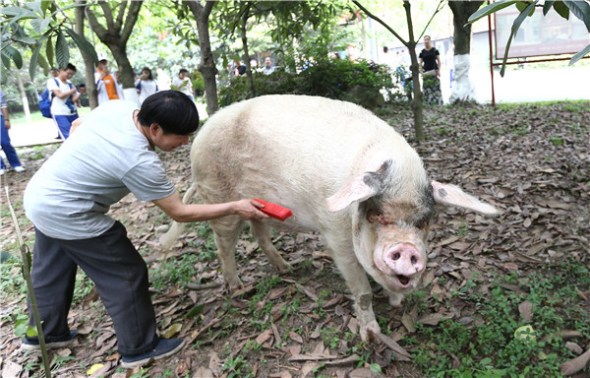
Breeder Gong Guocheng brushes Strong Pig as the animal takes a stroll at the Jianchuan Museum Cluster in Chengdu's Dayi county in Sichuan province earlier this month. (ZOU HONG/CHINA DAILY)
He Chunjin's mouth fell open and his eyes widened when he first caught sight of Strong Pig, the sow that survived for 36 days trapped under the rubble of the 2008 Wenchuan earthquake.
"She's amazing!" the excited 54-year-old exclaimed as he stared at the animal in her enclosure at the private Jianchuan Museum in Chengdu, Sichuan province.
"Her survival made her a superstar. And she really deserves the honor," he said, adding that he had traveled from Deyang, a city about 50 kilometers away, to commemorate the 10th anniversary of the disaster on Saturday.
Strong Pig - or Zhujianqiang in Chinese - became a symbol of hope when she emerged alive, covered in charcoal and drenched in rainwater, more than five weeks after the quake. At that time, she weighed about 50 kilograms.
After her story made headlines, the museum bought her for 13,800 yuan ($2,180) and relocated her to a 10-square-meter pen at the facility about 60 km from downtown Chengdu.
Since then, she has been a major draw at the museum, which also features installations of earthquake scenes and other temblor-related exhibitions. It is visited more than 1.4 million times a year.
"Strong Pig represents the resolute optimism people had after the disaster," said Gong Guocheng, whose job is to feed and care for the sow.
She is now 11 years old, equivalent to more than 80 human years, and she weighs more than 200 kg, he said. The average pig lives to age 15.
Gong said Strong Pig spends most of her time sleeping, but he takes her for walks around the park beside her enclosure twice a day, as "she needs regular exercise to stay healthy".
She enjoys a light diet of mixed vegetables and receives an annual health check, too. "It's a regimen to keep her living longer," he added. "I believe many Sichuan natives, including me, want to keep her around."
In 2012, Strong Pig underwent several operations to deal with an ulcer and other ailments. She also has rheumatism in her legs, which makes walking difficult.
"It's upsetting to see her getting older," Gong said. "Workers on the night shift will call me if they spot her acting abnormally. But to tell the truth, I hope they never need to call."
Perhaps in recognition of her status, Chinese scientists have cloned the pig several times. How many times is not known. The museum used to care for two of the clones but both died within two years.
He Chunjin, the visitor from Deyang, said seeing Strong Pig reminded him of the hard and hectic days in 2008 when, as a local government official, he was tasked with delivering emergency supplies in areas close to the quake's epicenter.
"Sorrow can be alleviated as time passes, but the feeling of strength I take from then will never disappear," he said.
Tang Haiyan, 23, who had traveled with friends to the museum from Suining, Sichuan, appeared as amazed as He when she spotted the star attraction.
"I really thought she'd died already," she said, looking at Strong Pig. "Her survival and long life are astonishing. Look how strong she is!"


















































